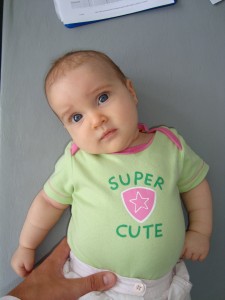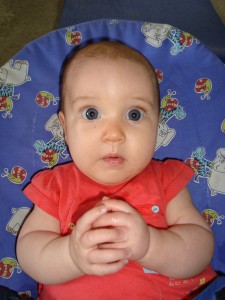 After 4 specific adjustments to Baby Brooke’s atlas, her head was on straight.
After 4 specific adjustments to Baby Brooke’s atlas, her head was on straight.
It’s good to start out looking life square in the eye.
Super Cute Baby Brooke was born with acquired torticollis, which means twisted neck. Acquired because it was brought about through the birthing process – a completely “normal” birth. But normal births can be quite traumatic with much strain placed on the fragile upper neck.
At 3 months of age (photo), her head looked like this for weeks and the usual response to parents with paediatric problems is, “they’ll grow out of it”.
Two years ago I met a father whose child had the same problem, but they were convinced by doctors to go the surgical route – even though the parents instinctively felt this was wrong – and the child’s sternocleidomastoid (SCM) muscle was severed to release the head (the big muscle running from behind your ear down to the front of your chest, used for turning the head). Because the SCM muscle has intimate connections with immune function and lymph glands, the child became repetitively ill for 2 or 3 years thereafter.
The top two cervical vertebrae (top two bones) are unique in their development to the rest of the spine.
 C1, or atlas, only turns into hard bone completely at age 7. C2, or axis, finishes ossifying between the ages of 6 and 12. Up until these ages in development, the vertebrae are like shark cartilage: pliable and adapting to outside forces that the growing child endures. These forces can start from birth when going through the birth canal or when being pulled from the womb by Caesarean section, forceps or ventouse. Then there are the usual bumps and falls as the child learns to crawl, walk and play. The neck takes a lot of strain and this starts altering the shape and orientation of the child’s upper cervical spine.
C1, or atlas, only turns into hard bone completely at age 7. C2, or axis, finishes ossifying between the ages of 6 and 12. Up until these ages in development, the vertebrae are like shark cartilage: pliable and adapting to outside forces that the growing child endures. These forces can start from birth when going through the birth canal or when being pulled from the womb by Caesarean section, forceps or ventouse. Then there are the usual bumps and falls as the child learns to crawl, walk and play. The neck takes a lot of strain and this starts altering the shape and orientation of the child’s upper cervical spine.
For optimal spine and brain development, it’s a good idea to get their neck checked.
In children younger than 8 years, maximum mobility occurs between C1 and C3. This is due to hypermobility of the immature, developing spine, ligamentous laxity, shallow-angled developing joints, a relatively heavy head and weak neck muscles. All of which makes the brainstem, spinal cord and nervous system susceptible to disturbance. Nervous system disturbance can possibly result in problems such as torticollis or wry neck, constipation, colic, problematic breast feeding, grumpiness, ear infections, bedwetting or poor sleep patterns.
